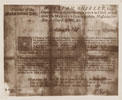 Artemas began his military career when he was commissioned as a major on January 28, 1755. He did not see active service for two and a half years after his appointment, but instead carried out his duties in the Worcester militia and continued to serve in several political offices. Artemas had no prior military experience, so his commission as a major was likely due to his family's position and his education at Harvard.
Artemas began his military career when he was commissioned as a major on January 28, 1755. He did not see active service for two and a half years after his appointment, but instead carried out his duties in the Worcester militia and continued to serve in several political offices. Artemas had no prior military experience, so his commission as a major was likely due to his family's position and his education at Harvard.